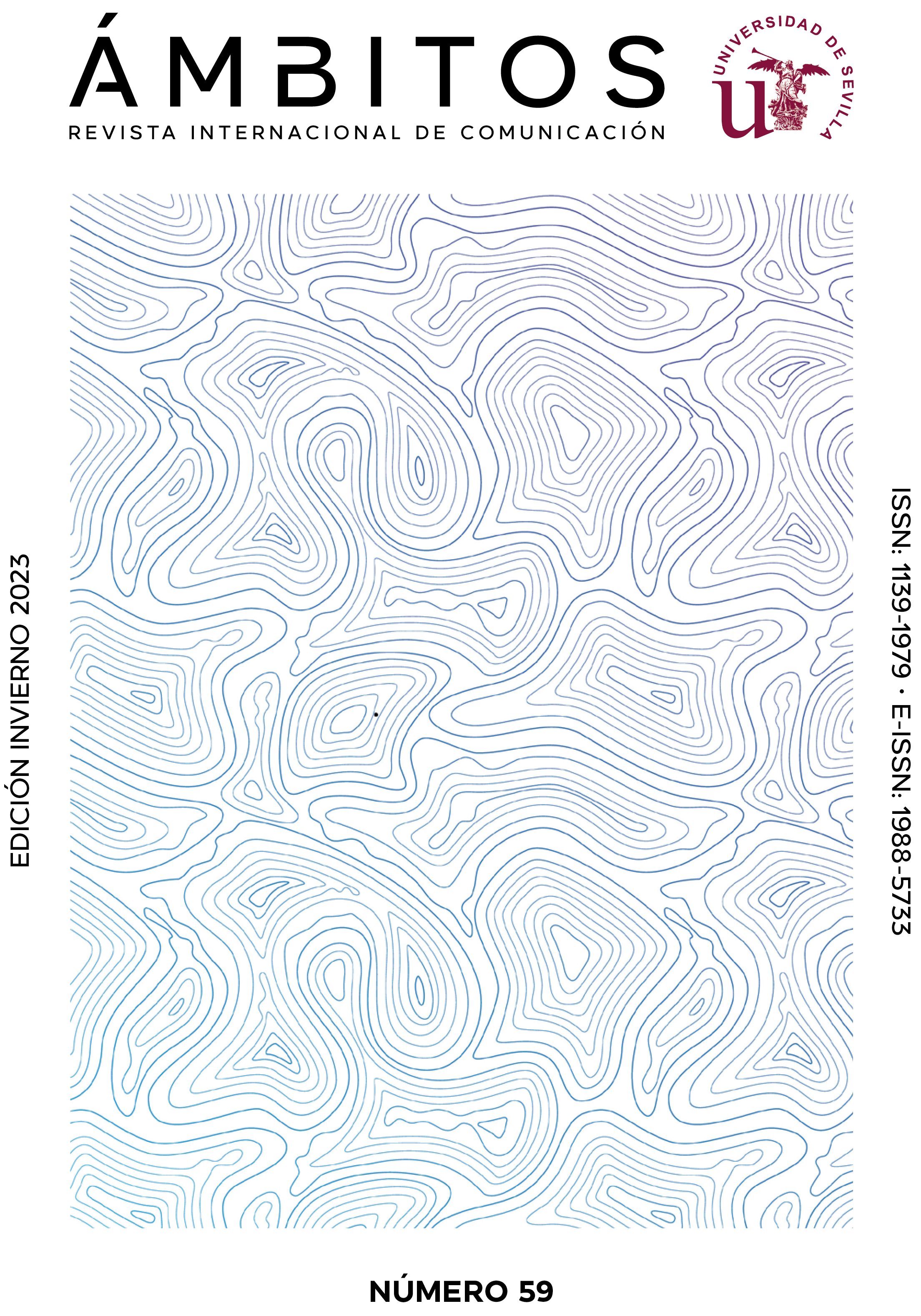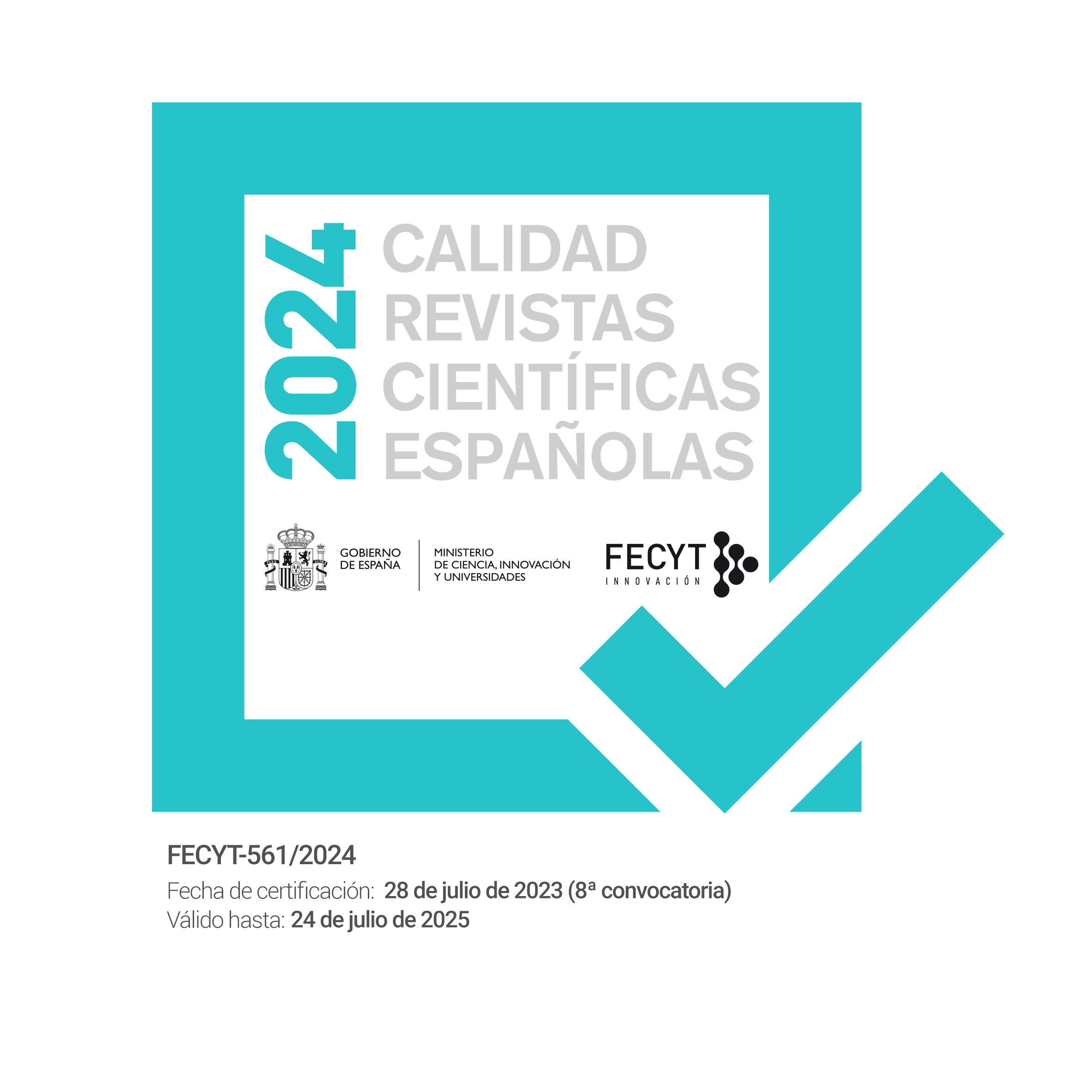A desconstrução da Beautiful Figthing Girl através do arquétipo Pygmalion.
Análise de NieR Automata (2017) a partir de uma perspectiva pós-estruturalista feminista.
DOI:
https://doi.org/10.12795/Ambitos.2023.i59.11Palavras-chave:
Beautiful Fighting Girl, Otaku, NieR Automata, Jogos de vídeo, CyborgResumo
Descrito por Tamaki Saitō em seu ensaio Beautiful Fighting Girl (2011 [2000]), este arquétipo corresponde a uma série de padrões específicos da ficção japonesa. De uma perspectiva lacaniana, o autor desvenda a psique do otaku, traçando uma estrutura onde a barreira entre ficção e realidade se esbate através do campo magnético da sexualidade e a histerização do sujeito em direção a figuras fictícias. Embora, por definição, sejam personagens femininas que intervêm no curso de seu trabalho e lutam para cumprir sua vontade, essas heroínas perpetuam códigos de fecundação decorrentes da cultura heteropatriarcal japonesa. Assim, e por meio deste paradoxo, fora das correntes feministas pós-estruturalistas do Ocidente, são criadas personagens orientadas para o olhar masculino desejoso. Entretanto, Taro Yoko, em seu videogame NieR Automata (2017), exibe personagens que escapam desses cânones, impondo um modelo mais próximo do feminismo socialista do Manifesto A Cyborg de Donna Haraway (1984). Devido à popularidade da Beautiful Fighting Girl no Japão e, por extensão, no Ocidente, após as recentes ondas neo-japonismáticas, esta pesquisa pretende servir àqueles designers de narrativas videolúdicas que buscam representações feministas adequadas aos discursos pós-modernos contemporâneos. Para este fim, será desenvolvida uma análise exaustiva dos componentes da obra e a contraposição simbólica de seus elementos.
Downloads
##plugins.generic.paperbuzz.metrics##
Referências
Aarseth, E. (1997). Cybertext: Perspectives on Ergodic Literature. Johns Hopkins University Press.
Aarseth, E. (1999). Aporia and epiphany in Doom and The Speaking Clock: The temporality of ergodic art. En M. Ryan (ed.), Cyberspace textuality: Computer technology and literary theory (pp. 31–41). Indiana University Press.
Aarseth. E. (2003, 28 – 29 de agosto). Playing Research: Methodological approaches to game analysis [ponencia] Conferencia de Artes Digitales y Cultura de Melbourne. Universidad de Bergen. Bergen, Noruega.
https://bit.ly/3DvG94w
Allouch, J. (2009). El sexo del amo. El Cuenco de Plata.
Álvarez, F. (2019). «Si haces esto, eres otaku»: reflexiones sobre las identidades constituidas a partir de objetos de la cultura de masas japonesa. Intersecciones en Comunicación, 13 (1), 235-256. http://bit.ly/3T42JH8
Azuma, H. (1999). Yubinteki fuantachi. Asahi Shinbusha.
Azuma, I. (productor ejecutivo). (1992-1997). Sailor Moon [serie de television]. Toei Animation.
Bailly, L. (2012). Lacan: A Beginner’s Guide. Beginner’s Guides.
Beck, V. Boys, S. Rose, C. y Beck, E. (2012). Violence Against Women in Video Games: A Prequel or Sequel to Rape Myth Acceptance? Journal of Interpersonal Violence, 27(15), 3016-3031.
https://doi.org/10.1177/0886260512441078
Bellah, R. N. (2003) Imagining Japan: The Japanese Tradition and its Modern Interpretation. University of California Press.
Bing, Y. Lin, M. Nonaka, A. y Beom, K. (2006). Harmony, Hierarchy and Conservatism: A CrossCultural Comparison of Confucian Values in China, Korea, Japan, and Taiwan. Communication Research Reports. 22, 107-115.
https://doi.org/10.1080/00036810500130539
Burgos, D. (2021). The Queer Glow up of Hero-Sword Legacies in She-Ra, Korra, and Sailor Moon. Open Cultural Studies, 5(1).
https://doi.org/10.1515/culture-2020-0135
Butler, J. (2007). El género en disputa. Paidós.
Caldwell, K. (2016). Fake the dawn: Digital game mechanics and the construction of gender in fictional worlds. [Tesis de Máster, Massachusetts Institute of Technology]. http://bit.ly/3Nu6ODk
Cockerill, J. (2019). Pretty guardians of a queer time and place. Voiceworks, 116, 33-38.
https://search.informit.org/doi/10.3316/informit.670997632795627
De Pablo Rodríguez, A. (2014). La tragedia de la rosa y la espada. Elementos simbólicos de masculinización en la mujer fálica del Shonen Manga. Kokoro: Revista para la difusión de la cultura japonesa, 14, 14-22.
http://bit.ly/3U2EZ7B
Delamorclaz, C. (2018). LGBTI y feminismo en animación televisiva: una reinterpretación de Steven Universe y Sailor Moon. Con A De Animación, 8, 164-177.
https://doi.org/10.4995/caa.2018.9655
Fernández, B. (2016) Análisis comparado de la representación femenina en la historieta y la construcción de arquetipos no sexistas. [Tesis Doctoral, Universidad de Oviedo]. https://bit.ly/3h7Zrp9
Fernández, B. (2019). Los secretos de las Magical Girl. Héroes de Papel.
Flores, A. y Velasco, P (coords). (2020). Ideological Games. Videojuegos e ideología. Héroes de Papel.
Frasca, G. (1999). Ludology meets Narratology: Similitude and Differences between (Video) Games and Narrative. http://bit.ly/3h7l9JZ
Grossman, R. (1980). Women’s place in the integrated circuit. Radical America, 14 (1), 29-50.
https://bit.ly/3FGQZaC
Haraway, D. (1984). Manifiesto Cyborg. Kaótica libros.
Hewlett, D. (2015). Anime and Identity: The Reception of Sailor Moon by Adolescent American Fans. East Asian Studies Summer Fellows, 1. http://bit.ly/3h6MVWY
Ito, M. Okabe, D. y Tsuji, I. (2012). Fandom Unbound. Otaku Culture in a Connected World. Yale University Press.
Jaćević, M. (2017, 28 – 1 de noviembre). «This. Cannot. Continue.» – Ludoethical Tension in NieR: Automata [conferencia] The Philosophy of Computer Games Conference. Universidad de Jagiellonian. Kraków, Polonia https://bit.ly/3WuSIpm
Joanette, Q. (2009). The Heroine’s reclamation of the girlish and the portrayal of girl-power in Sailor Moon. [Tesis Doctoral, Lakead University]. Library and Archives Canada. https://bit.ly/3NK23G9
Juul, J. (2001). Games Telling Stories? A Brief Note on Games and Narratives. Game Studies 1 (1).
http://bit.ly/3T0W2FX
Kinder, M. (1991). Playing with power in movies, television and video games: From Muppet Babies to Teenage Mutant Ninja Turtles. University of California Press.
https://doi.org/10.1525/9780520912434
Klevjer, R. (2001). Computer Game Aesthetics and Media Studies. Documento presentado para la conferencia 15th Nordic Conference on Media and Communication Research de Reykjavik, Islandia.
https://bit.ly/3haw9pG
Lacan, J. (1966-1967, 16 de noviembre – 21 de junio). La logique du fantasme. [seminario]. Faculté de Droit, Universidad de París. París, Francia. https://bit.ly/3Nsc7Dv
Lacan, J. (2001). Seminario 1: Los Escritos Técnicos de Freud. Paidós.
Lacan, J. (2003). Seminario 8: La transferencia. Paidós.
Lacan, J. (2013). Escritos 1. Biblioteca Nueva.
Lacan. J. (1999). Seminario 11: Los Cuatro Conceptos Fundamentales del Psicoanálisis. Paidós.
Lamarre, T. 2009. The Anime Machine: A Media Theory of Animation. University of Minnesota Press.
Latour, B. (1984). Les microbes, guerre et paix, suivi des irréductions. Métailié.
Latour, B. (2007). Nunca fuimos modernos. Siglo XXI Argentina.
López, F. y García, J. (2011). Arquetipos iconográficos femeninos en el cómic y la animación japonesa para adolescentes masculinos. [Ponencia]. Universidad de Sevilla. http://bit.ly/3zHZ4YL
MacKinnon, C. (1982). Feminism, Marxism, method, and the state: an agenda for theory. Signs, 7 (3), 515-544. https://doi.org/10.1086/493898
Mineau-Murray, L. (2021). Agentivités des personnages féminins dans les jeux de rôle japonais: le cas de Tales of. [Tesis de Máster, Université de Montréal]. https://bit.ly/3DTbY8U
Murray, Janet H. (1997). Hamlet on the Holodeck: The Future of Narrative in Cy-berspace. The MIT Press.
Nasio, J. (1998). Hysteria from Freud to Lacan: The Splendid Child of Psychoanalysis. The Other Press.
Navarro-Remesal, V. (2015). ¿La vida empieza o acaba con el matrimonio?: Amor, diseño de ética y libertad dirigida en Catherine. adComunica. Revista Científica de Estrategias, Tendencias e Innovación en Comunicación, 9, 43-61.
https://doi.org/10.6035/2174-0992.2015.9.4
North, D. C. (1981). Structure and Change in Economic History. Norton.
Ōtsuka, E. (1992). Kaso genjitsu hihyo [Critique of virtual reality]. Shin’yosha.
Ōtsuka, E. (2010). Word and Variation: The Reproduction and Consumption of Narrative. En F. Lunning (ed.), Mechademia 5 Fanthropologies (pp. 99-117). University of Minnesota Press
Ow, J. (2000). The revenge of the yellowfaced cyborg: The rape of digital geishas and the colonization of cyber-coolies in 3D Realms’ Shadow Warrior. En B. Kolko, L. Nakamura & G. Rodman (eds.), Race in cyberspace (pp. 51-68). Routledge.
Prough, J. (2011) Straight from heart: gender, intimacy, and the cultural production of shōjo manga. University of Hawai’s Press.
Shamoon, D. (2012). Passionate friendship: the aesthetics of girl’s culture in Japan. University of Hawai’s Press. https://doi.org/10.21313/hawaii/9780824835422.001.0001
Solberg, R. (2021). Playing posthumanism? NieR: Automata and the inescapable human. Documento presentado para la conferencia Literary and Aesthethic Posthumanism de Bergen. https://bit.ly/3sSQH8W
Sugimoto, Y. (2010). An Introduction to Japanese Society. Cambridge University Press.
https://doi.org/10.1017/CBO9780511781223
Takahashi, M. (2008). Opening the Closed World of Shōjo Manga. En M.W. MacWilliams (ed.), Japanese Visual Culture Explorations in the World of Manga and Anime (pp. 114-136). M.E. Sharpe.
Tamaki, S. (2011). Beautiful Fighting Girl. University of Minnesota Press.
https://doi.org/10.5749/minnesota/9780816654505.001.0001
Taro, Y. (2017). NieR: Automata (Versión PlayStation 4) [Videojuego]. Square Enix.
Vaz, B. (2016). La convergencia ludo-narratológica en el diseño de videojuegos de rol: las mecánicas jugables de Dark Souls contra el diagrama de flujo de Mass Effect. Comunicología Cubana, 92, 1-28.
Vossen, E. (2020). There and Back Again Tolkien, Gamers, and the Remediation of Exclusion through Fantasy Media. Feminist Media Histories. 6(1), 37-65. https://doi.org/10.1525/fmh.2020.6.1.37
Zeigler, B. (2000). Theory of Modeling and Simulation. Academic Press.
Žižek, S. (2003). El espectro de la ideología. En S. Žižek (comp.), Ideología: un mapa en cuestión (pp. 7-42). Fondo de cultura económica.
Downloads
Publicado
Como Citar
Edição
Seção
Licença
Copyright (c) 2023 Carlos Álvarez Barroso

Este trabalho está licenciado sob uma licença Creative Commons Attribution-NonCommercial-ShareAlike 4.0 International License.
Ámbitos. Revista Internacional de Comunicación é um jornal de acesso aberto, o que significa que todo o conteúdo está disponível gratuitamente para o usuário ou sua instituição. Os usuários podem ler, baixar, copiar, distribuir, distribuir, imprimir, pesquisar ou vincular ao texto completo dos artigos, ou utilizá-los para qualquer outra finalidade lícita, sem solicitar permissão prévia da editora ou do autor. Esta definição de acesso aberto está de acordo com a Iniciativa de Acesso Aberto de Budapeste (BOAI).

A menos que seja observado o contrário, todo o conteúdo da edição eletrônica é distribuído sob uma "Licença Internacional Creative Commons Attribution-NonCommercial-ShareAlike 4.0". Você pode consultar a versão informativa e o texto legal da licença aqui. Isto deve ser expressamente declarado desta forma, quando necessário.
No caso de aceitação do manuscrito, os autores cedem os direitos da obra para sua publicação à Ámbitos. Revista Internacional de Comunicación sob o contrato de licença Attribution-NonCommercial-ShareAlike 4.0 International (CC BY-NC-SA 4.0). Os autores retêm os direitos autorais e terceiros estão autorizados a copiar, distribuir e fazer uso da obra, desde que cumpram os termos e condições estabelecidos na licença
- Cite a autoria e a fonte original de publicação (revista, editora e URL da obra).
- Não utilizá-los para fins comerciais.
- Se você remixar, transformar ou criar a partir do material, você deve liberar suas contribuições sob a mesma licença que o original.
Mais informações podem ser encontradas em
https://creativecommons.org/licenses/by-nc-sa/4.0/deed.es
- Resumo 426
- PDF (Español (España)) 126
- XML (Español (España)) 152


















